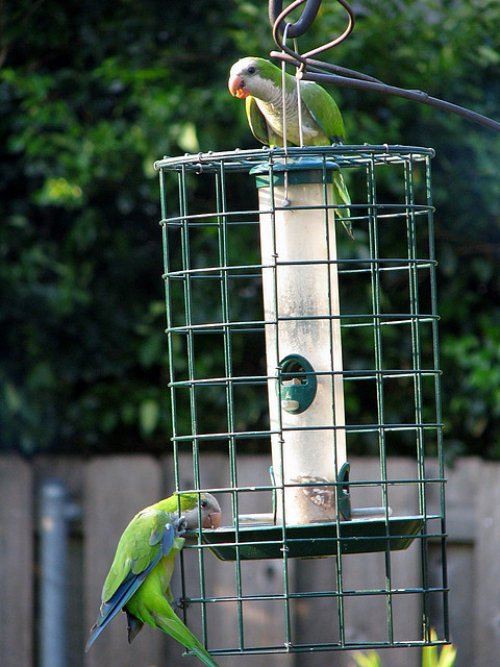 Houston monk parakeets. Image by Shelly and Roy JohnsonWhen artist June Woest moved into her Bellaire studio, she was surprised to find a colony of green parrots had set up housekeeping in the gigantic transmission towers behind it. A group of monk parakeets - the Polly-wanna-cracker kind of parrot sold in pet stores - had apparently escaped their cages and were doing just fine on their own.
Houston monk parakeets. Image by Shelly and Roy JohnsonWhen artist June Woest moved into her Bellaire studio, she was surprised to find a colony of green parrots had set up housekeeping in the gigantic transmission towers behind it. A group of monk parakeets - the Polly-wanna-cracker kind of parrot sold in pet stores - had apparently escaped their cages and were doing just fine on their own.
In the past three decades or so, that story has played itself out across North America. Monk parakeets, from Argentina, were imported to the U.S. in large numbers starting in the 1960s. When the pet birds got loose in urban areas, many fended for themselves, found mates, and raised feral babies. Like pigeons, they're natural-born city birds.
In the wild, monk parakeets build their nests in dead trees. American cities don't offer many of those, so the birds did what immigrants everywhere do: They improvised.
They claimed cell phone towers, stadium lights and pretty much any other large metal structure that would support their extravagant nests: condominiums, really, collections of stick nests for many family units. Bird experts say a typical monk parakeet condo, the size of a pickup truck's bed, can weigh more than 400 pounds and house 20 breeding pairs.
Woest points to a big nest.
"That was the first one, when I moved in 18 years ago," she says.
Now, the transmission tower holds five more condo-nests. And the birds have claimed another cell tower nearby. They walk upside-down on the nests. They perch in pairs on the tower. They chitter. And sometimes they fly, green against the sky.
Here, in the middle of Houston, is a flock of maybe 150 wild parrots.
Invasive species?
"Technically, they're an invasive species," says David Sarkozi, of the Houston Ornithological Society. "Just like the tallow trees and Japanese honeysuckle I spend my weekends trying to kill at the Anahuac Wildlife Refuge." He and Dan Brooks, the curator of vertebrate zoology at the Houston Museum of Natural Science, have included monk parakeets in a study of nonnative birds living in Texas.
But Sarkozi doesn't argue that the parrots should be eradicated like tallow trees. "They're charismatic birds," he says, and notes that people love to spot them.
 Monk parakeet sitings in Harris County [Map generated by ebird.org] He maintains a Web database of bird sightings, and on it, he showed me a map of Harris County's monk parakeet sightings. (You can re-create it for yourself on ebird.org.) The pattern runs diagonally through the county, northeast to southwest - along the line, Sarkozi notes, where a hundred years ago the prairie met the forest. That's the kind of place a parrot likes to live: one where it can build its condo nest high in a dead tree, but forage for food on the ground. Or, in our degraded world, build atop stadium lights, but find breakfast on a soccer field.
Monk parakeet sitings in Harris County [Map generated by ebird.org] He maintains a Web database of bird sightings, and on it, he showed me a map of Harris County's monk parakeet sightings. (You can re-create it for yourself on ebird.org.) The pattern runs diagonally through the county, northeast to southwest - along the line, Sarkozi notes, where a hundred years ago the prairie met the forest. That's the kind of place a parrot likes to live: one where it can build its condo nest high in a dead tree, but forage for food on the ground. Or, in our degraded world, build atop stadium lights, but find breakfast on a soccer field.
Or a college campus. Sarkozi's day job is with the University of Houston's police department. A flock of monk parakeets has established itself in a cell phone tower near Elgin, and sometimes Sarkozi sees the green birds flying up and down Scott Street, skirting the parking lots.
Those parrots interested visiting artist Brian Collier, who salutes plants and animals that flourish in "severely human-altered habitats." Recently, as part of an art project he calls The New Parrots of North America, Collier built a 9-foot bird feeder intended to help UH's parrots make it through the winter.
Collier and Sarkozi argue that the monk parakeets don't seem to be displacing Texas' native birds. Because the parrots favor human-built objects for nesting, their colonies grow on structures few other birds would envy.
It's even possible, Collier and Sarkozi say, that monk parakeets fill an ecological niche that was vacant when they arrived in North America. The Carolina parakeet (Conuropsis carolinensis), the only parrot native to eastern North America, was a gregarious red-yellow-and-green bird. It went extinct in 1939 - the victim, most likely, of over-hunting and habitat destruction.
Where the Carolina parakeet faltered, the monk parakeet thrives. It's estimated that 5,000 live wild in the U.S.
By saluting the wild parrots, Collier hoped to draw attention to the ecology we live in - not a pristine, pre-Columbian natural world, but an urban one full of creatures with back stories.
Unfortunately, the artist's parrot feeder didn't attract UH's parrots. Sarkozi guesses it wasn't visible enough.
But the parrots didn't seem to need it. They're doing fine on their own.